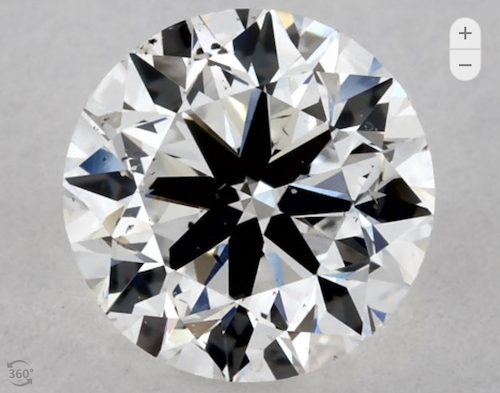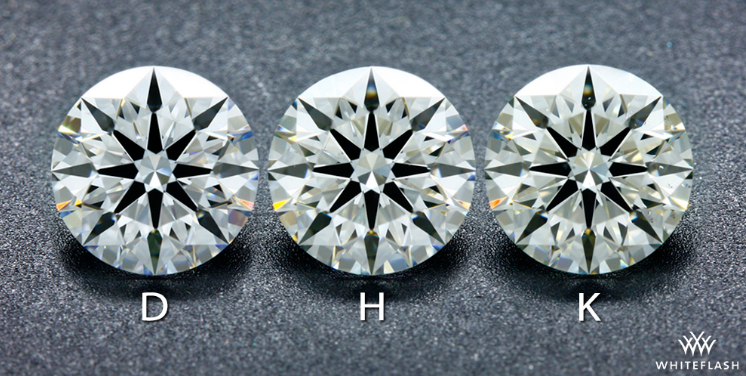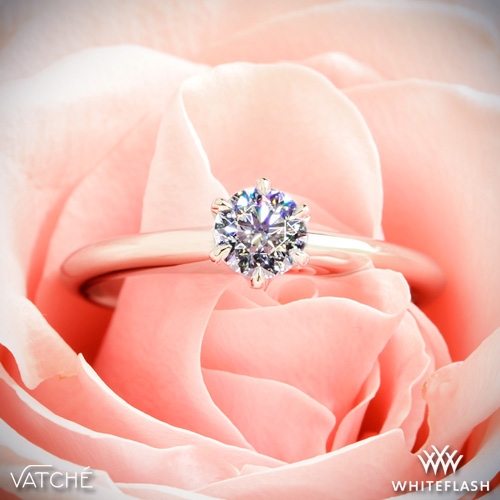This article has mentions of products from one or more companies, and I may receive compensation if you purchase those products following reading my recommendations.
Welcome to the world of unparalleled brilliance and purity - the world of D color diamonds. These precious stones represent the pinnacle of the diamond color grading scale, a perfect embodiment of colorless beauty. D color diamonds are the highest grade on the Gemological Institute of America (GIA) color scale, renowned for their exceptional rarity and value.
To the untrained eye, most diamonds may appear colorless, but to gemologists and diamond enthusiasts, the subtle variations in color can significantly impact a diamond's quality and price. Among the spectrum of diamond colors, D color diamonds stand out as the epitome of icy elegance and luminosity, a trait that sets them apart and places them in a class of their own.
In this guide, we'll delve into the captivating realm of D color diamonds, exploring their unique characteristics, their rarity, and their worth. We'll also provide valuable insights to help you make an informed choice if you're considering a D color diamond for your next piece of jewelry.
Join us on this journey as we uncover the extraordinary allure of D color diamonds.
Summary:
- What Are D Color Diamonds?
- Characteristics of D Color Diamonds
- The Rarity and Value of D Color Diamonds
- Choosing a D Color Diamond
- Caring for D Color Diamonds
- Conclusion
- FAQs
What Are D Color Diamonds?
Diamonds, one of the world's most revered precious stones, come in a variety of colors, from completely colorless to light yellow or brown. But among this spectrum, D color diamonds occupy a position of unrivaled prestige. These diamonds are completely colorless, making them the purest diamonds when it comes to color.
To understand the significance of D color diamonds, it's essential to understand the Gemological Institute of America (GIA) color grading scale. This scale classifies diamonds from D (colorless) to Z (light yellow or brown). The closer a diamond's grade is to D, the less color it has, and therefore, the higher its quality and value.

D Color Diamond from James Allen
So, what sets D color diamonds apart? Simply put, they are the diamonds that have achieved the highest possible rating on this scale. When viewed through the pavilion (the bottom portion of the diamond) in a face-down position under controlled lighting conditions, these diamonds show no discernible color. They are the epitome of perfection in terms of color, representing the top 1% of all diamonds in the world.
However, it's important to remember that color is just one aspect of a diamond's overall quality. Other factors, such as cut, clarity, and carat weight (collectively known as the 4Cs), also play a crucial role in determining a diamond's appearance and value. But when it comes to color, nothing surpasses a D color diamond.
In the following sections, we'll explore the unique characteristics of D color diamonds, their rarity, and their value. We'll also provide some tips for those considering purchasing a D color diamond. Whether you're a diamond connoisseur or a novice in diamond buying, understanding the unique allure of D color diamonds can enhance your appreciation for these exceptional gemstones.
Characteristics of D Color Diamonds
The most defining characteristic of D color diamonds is, as you might guess, their color—or rather, their lack of it. D color diamonds possess a level of transparency that is unmatched by any other grade on the GIA color scale. This absolute absence of color results in a diamond that reflects light in its purest form, producing unparalleled brightness and sparkle.
When you look at a D color diamond, you're witnessing pure, unadulterated light reflection. This is why they are often described as having an "icy" or "crystal clear" appearance. The colorlessness of a D color diamond means that nothing interferes with the path of light through the diamond. The result? A stone that radiates with maximum brilliance and fire—the terms used to describe how a diamond reflects light.

D vs H vs K Color Diamonds - Image: Whiteflash
Comparatively, diamonds with a lower color grade—even those that are near-colorless, such as G or H color diamonds—contain slight traces of yellow or brown that can subtly influence their overall appearance. While these color differences may not be immediately apparent to the untrained eye, especially when viewed in the face-up position, they become more noticeable when compared side-by-side with a D color diamond.
However, it's important to note that the exceptional color grade does not automatically guarantee a more beautiful diamond. The overall beauty of a diamond is also heavily influenced by its cut and clarity. A well-cut diamond with a lower color grade can often appear more brilliant than a poorly cut D color diamond. Similarly, a D color diamond with noticeable inclusions (internal flaws) might be less attractive than a flawless diamond of a lower color grade.
Ultimately, the allure of D color diamonds lies in their rare ability to offer the purest reflection of light. This quality makes them the embodiment of icy elegance and luminosity. Whether or not a D color diamond is the right choice for you will depend on your personal preferences, as well as other factors we'll discuss in the following sections.
The Rarity and Value of D Color Diamonds
As the highest grade on the GIA color scale, D color diamonds are incredibly rare. Their exceptional purity and colorlessness are found in less than 1% of all diamonds mined worldwide, which contributes to their high demand and value.
Diamonds are formed over billions of years under extreme heat and pressure deep within the Earth. The conditions during their formation often result in the presence of trace elements and structural imperfections that influence the diamond's color. Nitrogen, for example, is a common trace element in diamonds that imparts a yellowish hue. The complete absence of these influencing factors in D color diamonds—resulting in their perfect colorlessness—is a testament to their rarity.
When it comes to their value, D color diamonds command the highest prices. The price of a diamond increases significantly with higher color grades due to the increased rarity. Therefore, D color diamonds are often the most expensive diamonds per carat, especially when they also score highly on the other 3Cs (Cut, Clarity, and Carat weight).
However, it's crucial to remember that the value of a diamond is not determined by its color alone. A large, D color diamond with poor clarity might be less valuable than a smaller diamond with lower color grade but exceptional clarity. Similarly, the cut quality of a diamond—how well it's been shaped and faceted from its rough state—also greatly impacts its value. A poorly cut D color diamond won't reflect light as brilliantly as a diamond with a lower color grade but a superior cut.
In the end, while D color diamonds hold a special allure due to their extraordinary rarity and colorless beauty, it's essential to consider all aspects of a diamond when assessing its value. This understanding will serve you well in making an informed decision when you're in the market for a diamond.
Choosing a D Color Diamond
When choosing a D color diamond, there are several factors to consider. First and foremost, remember that while color is a critical component of a diamond's value, it's not the only one. Cut, clarity, and carat weight—often referred to collectively as the 4Cs—also play a vital role in determining a diamond's overall quality and appeal.
The cut of a diamond significantly affects its brilliance. Even a D color diamond won't sparkle to its fullest potential if it's poorly cut. Therefore, always prioritize a high-quality cut. A well-cut D color diamond will reflect light beautifully, maximizing its natural brilliance and fire.
Clarity is another essential consideration. Diamonds with fewer inclusions (internal flaws) and blemishes (external flaws) will appear more brilliant and are typically more valuable. A D color diamond with a high clarity grade will showcase its colorless nature better than one with noticeable inclusions.
Carat weight is largely a matter of personal preference and budget. However, it's worth noting that color is easier to detect in larger diamonds. So, the value of a D color diamond becomes more apparent as the size of the diamond increases.
Lastly, consider the diamond's shape and setting. Some shapes and settings may emphasize the diamond's color more than others. For instance, a round brilliant cut tends to hide color better than other shapes, while a white gold or platinum setting can complement a D color diamond's colorless nature.
Caring for D Color Diamonds
Caring for a D color diamond is similar to caring for any other diamond. Here are some tips to help you maintain its brilliance and beauty:
Regular Cleaning: Clean your diamond regularly to remove any dirt, oil, or residue that may accumulate over time. You can do this at home using a mild soap and warm water solution and a soft toothbrush. Be gentle when scrubbing to avoid scratching the setting.
Professional Check-ups: Have your diamond jewelry inspected by a professional jeweler every six months to a year. They can check for any damage or loose settings and give your diamond a professional cleaning.
Safe Storage: Store your D color diamond jewelry separately from other pieces to prevent scratches or damage. A fabric-lined jewelry box with separate compartments is a great option.
Avoid Harsh Chemicals: Remove your D color diamond jewelry when cleaning, swimming, or doing any activity that might expose it to harsh chemicals or abrasive materials.
Insure Your Diamond: Given the high value of D color diamonds, it's a good idea to have your diamond jewelry insured. This will protect you financially in case of loss, theft, or damage.
Remember, a D color diamond is a rare and valuable possession. With the right care and attention, it will continue to sparkle and shine for generations to come.
Conclusion
D color diamonds represent the pinnacle of colorless beauty in the world of diamonds. These rare and valuable gems offer an unmatched level of purity and brilliance that makes them a coveted choice for many diamond buyers. However, as we've explored in this guide, choosing a D color diamond—or any diamond, for that matter—requires a careful consideration of all aspects of the diamond's quality, including its cut, clarity, and carat weight. With a clear understanding of these factors and with the right care, a D color diamond can be a sparkling symbol of elegance and luxury that lasts a lifetime.

